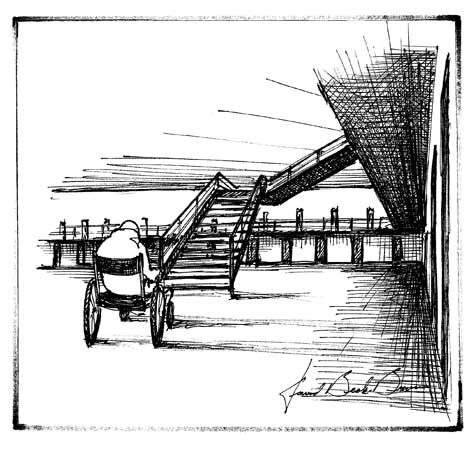

| |
|  (Political Cartoon by David Beck-Brown) Can Our Prisons Afford It?
By David Beck-Brown Dismantling California's prison programs confounds seasoned correctional staff. Nothing like this has ever happened before. Previous prison programs were designed to rehabilitate inmates, provide them with job skills, or simply to keep them and their hands busy. Eliminating these programs is a red flag signaling future disaster, in and out of prison. Vocational Education, Hobby Crafts, Arts in Corrections, Community Work Crews and exercise yards with free weights have been eliminated or emasculated. The prison Vocational Education programs are gone. Machinery collects dust. Prison factories stand idle, empty as discarded steel mills. Equipment, tools and supplies are being removed and placed for future auction. It took over twenty years to build these programs and one year to see them eliminated. Inmates once manufactured eye glasses, lenses, clothing and other products. These programs provided inmates with an incentive to learn employable skills such as automobile repair, auto body and paint, janitorial services, and electronics. No more. They also provided inmates with a motivation to improve their behavior; misbehave and they were out of the program. This gave staff leverage and created a safer work environment. California’s economy will improve one day; however, when it does, the cost of replacing these programs and the machinery may be financially prohibitive. While working on a prison yard recently, a lifer asked me about the prison Hobby Crafts program. He said he specializes in bead work. Other inmates create leather goods, belts, wallets and officer emergency alarm holders. Some work with folded paper making picture frames, or artwork for sale. Hobby Crafts is being eliminated. Without an avenue to sell their work many inmates will be unable to buy tooth paste, deodorant or items we refer to as incidentals. I know of one penniless inmate who uses peanut butter for deodorant and jam for his hair tonic. “If I can't sell my beadwork, I'll be forced to make money doing things I don't want to do.” I knew this wasn't a threat. This lifer was merely responding to the changes taking place within the California prison system. While incarcerated, convicts can make money by trafficking illicit drugs, or contracting themselves to make hits on other inmates or staff. Staff were once off limits. No more. Thirteen correctional officers were injured in one recent prison riot alone. A significant segment of the prison population has reading and anger problems and will act out their frustration when not preoccupied with activities. Aggression was once managed by providing weight lifting to inmates. California Governor Arnold Schwartzenegger knows the benefits of weight lifting. Every prison yard had an exercise area larger than a full tennis court. Inmates would use this privilege of pumping iron and bulking up. If they misbehaved, the privilege was taken away from them. As they developed their exercise routine, their bodies became disciplined and healthy. Seeing these changes, many inmates stopped using drugs while in prison. A warden told me that the inmates pumping iron weren't the ones causing him trouble. Despite these benefits, several years ago radio talk shows successfully crusaded against the program and the prison weights were eliminated. The Arts in Corrections program once served as an emotional and creative outlet for prison inmates. It was documented to reduce inmate recidivism as it paid for itself. Now, its contract artists have been eliminated. Arts in Corrections is now a thinly veiled early release program, designed to get inmates out of prison for the purpose of saving the cost of their incarceration. Do you recall seeing prison work crews clearing trash from our public parks, river bottoms, trolley and Cal Trans sites lately? These services were provided for free. The prison work crews were composed of eight to eleven well-behaved, minimum security inmates. The inmates looked forward to getting away from prison. They were on their best behavior on and off prison grounds. The community programs have ended. The crews that continue to work in our community are contracted out, working for profit. Can California afford to eliminate inmate programs at the cost of public safety? What is the medical cost for rehabilitating an injured correctional officer? Now, multiply this cost by thirteen, the number of injured officers in only one prison riot. There are 33 state prisons in California and all of them have several segregated prison yards. Riots are common in every prison and in most yards. Now, add the cost of paying the officers’ salary during their convalescence. Inmate programs are designed to relieve the emotional tensions inherent within our penal system. How much money does it cost to clean up after a prison riot, or to treat injured inmates? With an abundance of lifers being sentenced through California’s mismanaged 3-strikes law, how much more will it cost us to care for aged and ailing inmates who pose no threat to society? With little consideration to the human factor, or to the long range impact on California, the previous prison administration eliminated these programs as a quick fix solution to the recent budget crises. The consensus of many people working in our prisons is that this short fix solution will have dire consequences to the future safety and welfare of California. As a child, I was told not to be penny wise and dollar foolish. Some lessons are worth remembering.
Beck-Brown is prison-reform chair with the San Diego-based A New PATH (Parents For Addiction Treatment & Healing). PATH is a member organization of the Sacramento-based Coalition for Effective Public Safety. |
||